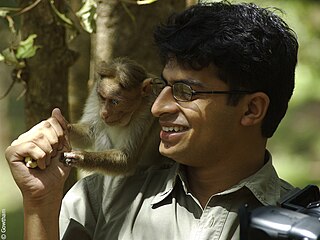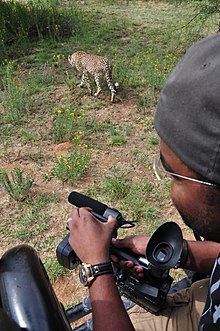
Sir David Frederick Attenborough is a British broadcaster, biologist, natural historian and author. He is best known for writing and presenting, in conjunction with the BBC Natural History Unit, the nine natural history documentary series forming the Life collection, a comprehensive survey of animal and plant life on Earth.

Life on Earth: A Natural History by David Attenborough is a British television natural history series made by the BBC in association with Warner Bros. Television and Reiner Moritz Productions. It was transmitted in the UK from 16 January 1979.

The Blue Planet is a British nature documentary series created and co-produced by the BBC and Discovery Channel. It premiered on 12 September 2001 in the United Kingdom. It is narrated by David Attenborough.
The BBC Studios Natural History Unit (NHU) is a department of BBC Studios that produces television, radio and online content with a natural history or wildlife theme. It is best known for its highly regarded nature documentaries, including The Blue Planet and Planet Earth, and has a long association with David Attenborough's authored documentaries, starting with 1979's Life on Earth.

Natural World is a strand of British wildlife documentary programmes broadcast on BBC Two and BBC Two HD and regarded by the BBC as its flagship natural history series. It is the longest-running documentary in its genre on British television, with nearly 500 episodes broadcast since its inception in 1983. Natural World programmes are typically one-off films that take an in-depth look at particular natural history events, stories or subjects from around the globe.

Planet Earth is a 2006 British television series produced by the BBC Natural History Unit. Five years in the making, it was the most expensive nature documentary series ever commissioned by the BBC and also the first to be filmed in high definition. The series received multiple awards, including four Emmy Awards, a Peabody Award, and an award from the Royal Television Society.

Neil Nightingale is a British freelance wildlife filmmaker, executive producer and creative consultant with over 35 years experience at the BBC. From 2009 to 2018 he was the creative director of BBC Earth, BBC Worldwide's global brand for all BBC nature and science content.

Alastair David William Fothergill is a British producer of nature documentaries for television and cinema. He is the series producer of the series The Blue Planet (2001), Planet Earth (2006) and the co-director of the associated feature films Deep Blue and Earth.
John Michael Salisbury, is an English documentary filmmaker specialising in natural history programmes for television. In a career spanning four decades, he spent over 30 years working for the BBC Natural History Unit where he produced a string of award-winning series, many in collaboration with David Attenborough. He retired from the Unit in 2006 but continues to work as a freelance producer. In 2007, he was made an OBE in the New Year Honours List for his services to broadcasting.
William Goodchild is a composer, orchestrator and conductor who produces music for film, television and the concert hall.

James Honeyborne is the creative director of Freeborne Media, he previously worked as an executive producer at the BBC Natural History Unit where he oversaw some 35 films, working with multiple co-producers around the world. His projects include the Emmy Award and BAFTA-winning series Blue Planet II, the Emmy Award-nominated series Wild New Zealand with National Geographic, and the BAFTA-winning BBC1 series Big Blue Live with PBS.

Life is a British nature documentary series created and produced by the BBC in association with The Open University. It was first broadcast as part of the BBC's Darwin Season on BBC One and BBC HD from October to December 2009. The series takes a global view of the specialised strategies and extreme behaviour that living things have developed in order to survive; what Charles Darwin termed "the struggle for existence". Four years in the making, the series was shot entirely in high definition.
The following is a chronological list of 148 television series and individual programmes in which Sir David Attenborough is credited as a writer, presenter, narrator, producer, or interviewee. In a career spanning eight decades, Attenborough's name has become synonymous with the natural history programmes produced by the BBC Natural History Unit.

Mike Gunton is a British television producer and a senior executive at the BBC Natural History Unit, the world's largest production unit dedicated to wildlife film-making. In November 2009 he became the Unit's first Creative Director.
Attenborough: 60 Years in the Wild is a three-part BBC documentary series chronicling the 60 years career making wildlife programmes of Sir David Attenborough. The first hour-long programme, titled "Life on Camera" was broadcast on Friday 16 November 2012 on BBC Two at 9pm. The second part, "Understanding the Natural World" and third and final part, "Our Fragile Planet" were broadcast on following Fridays, 23 and 30 November 2012.

Kalyan Varma is a Bangalore-based wildlife emmy nominated filmmaker, photographer and conservationist. He is one of the founders of Peepli Project, co-director of Nature InFocus nature and wildlife festival, and founding member of India Nature Watch. He currently freelances with BBC Natural History, Netflix, Discovery Channel, National Geographic and Disney+, and also works with grassroots NGOs like Nature Conservation Foundation to highlight environmental issues in India. He is a recipient of the National film awards for his film Wild Karnataka and Carl Zeiss Wildlife Conservation Award.

Planet Earth II is a 2016 British nature documentary series produced by the BBC as a sequel to Planet Earth, which was broadcast in 2006. The series is presented and narrated by Sir David Attenborough with the main theme music composed by Hans Zimmer.
Planet Earth is a television and film documentary franchise produced and broadcast by the BBC. The franchise began in 2001 with the success of The Blue Planet. As of 2017, The Blue Planet has spawned 5 series and one feature film.
Justine Evans is a British wildlife filmmaker featured in many BBC Natural History Unit productions such as Planet Earth, Life, and Frozen Planet. She is a canopy specialist and an expert on filming nocturnal animals.

Our Planet is a British nature documentary series made for Netflix. The series is narrated by David Attenborough and produced by Silverback Films, led by Alastair Fothergill and Keith Scholey, who also created BBC documentary series Planet Earth, Frozen Planet and The Blue Planet, in collaboration with the conservation charity World Wildlife Fund (WWF). The soundtrack was composed by Steven Price.













